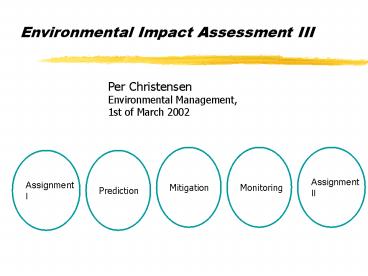Environmental Impact Assessment I - PowerPoint PPT Presentation
1 / 20
Title:
Environmental Impact Assessment I
Description:
Recapitulate. Methods for ... Recapitulate. Methods for impact prediction. Examples: ... Recapitulate. Prediction and significance. Magnitude - Short ... – PowerPoint PPT presentation
Number of Views:54
Avg rating:3.0/5.0
Title: Environmental Impact Assessment I
1
Environmental Impact Assessment III
Per Christensen Environmental Management, 1st of
March 2002
Mitigation
Monitoring
Assignment II
Prediction
Assignment I
2
Introduction to assignment I
- The aim of this assignment is to have the groups
discuss the meaning of quality related to the
Environmental Impact Statement. Thus, the key
questions addressed in this assignment are - 1. How do you determine if an Environmental
Impact Statement is of good quality? - 2. Which factors have an influence on obtaining a
good quality statement? - Presentation Friday the 1st of March, 9.00 -
10.00.
3
Lets have a BREAK !
4
The steps in the EIA process
- Screening
- Scoping
- Impact prediction
- Alternatives
- Mitigation measures
- EIS report
- Monitoring
Public participation
Decision making
5
Public participation - what is that ?
- The purpose of public participation are to
- give information
- get information
- establish credibility
- resolve conflicts
6
Types of effects
Recapitulate
- Physical, socio-economic
- Direct and indirect
- Short-term and long-term
- Local, regional..global
- Positive and negative
- Qualitative and quantitative
- Distribution on communities and/or areas
- Actual or estimated
- etc.
7
Methods for scoping
Recapitulate
- Guidelines
- Existing environmental statements of relevance
for the specific action - Checklists
- Consultation of
- (environmental)authorities, NGOs, the public and
so on - Consultants and experts
8
Methods for impact prediction
Recapitulate
- Examples
- Checklists
- Matrices
- Cause-effect flow diagram
- Mass balance models describes physical changes
(e.g. water in a stream) - Physical, image or architectural models
- Analogue models compares with existing
developments - Remember The whole EIA is about prediction!
9
Prediction and significance
- Magnitude
- - Short-term/long-term
- - Direct/indirect etc. Assessment Significance
- - Regulation
- Sensitivity of the - The public opinion
- affected environment - cost benefit
- - The number of people being affected - multiple
criteria - - The type of area/environment etc.
Subjective methods (Value judgements)
Objective methods
10
PredictionLiving with uncertainty
- EIA process Main type of Final certainty by Way
of - element uncertainty reduction
- Information Uncertainty of Implementation Researc
h - information
- Approach Uncertainty of Decision taking e.g.
negotiation - values
- Decision Uncertainty of Evaluation Co-ordination
- related decision
- ( Wathern, 1988)
11
Mitigation
- ..the measures envisaged to prevent, reduce and
where possible offset any significant adverse
effects on the environment - ( Ministry of the Environment and Energy,
Ministerial order., 2000) - Mitigation measures may include
- process alterations to reduce emissions
- altering pollution control equipment to render it
more effective - adjusting the hours of operation of a plant
- changing site layout to reduce visual, noise or
air pollution impacts - the requirement of fencing and walls
- the provision of mounding and planing
- the creation of replacement habitat etc.
12
Different mitigation measures
Compare with the list of different alternatives
13
Types of alternatives
- The proposed alternative
- e.g. coal fires power plant
- The zero alternative
- e.g. no power plant
- Alternative locations
- Alternative technological production processes
- Alternative ways of achieving the same end
- e.g. wind energy and bio mass
- Demand reduction alternative
- e.g. energy saving
14
Guidelines for drafting effectivemitigation
measures
- WHY State the objective of the mitigation
measure and why it is recommended - WHAT Explain the specifics of the mitigation
measure and how it will be designed and
implemented - WHO Identify the agency, organisation, or
individual responsible for implementing the
measure - WHERE Identify the specific location of the
mitigation measure - WHEN Develop a schedule for implementation.
15
Lets have a BREAK !
16
Monitoring
- The Environmental Impact Statement is no more
than a record of the forecast impacts of the
action as it is designed at a particular point in
time! - Further design work will take place
modifications - The life-cycle of a project may cover a long
period.
17
Implementation monitoring
- Involves checking that
- the project has been implemented in accordance
with the approval - that mitigation measures correspond with those
required - that conditions imposed upon action (e.g. noise
emission limits) have been met. - May involve
- physical inspection (e.g. of waste storage)
- measurement (e.g. noise emissions)
18
Impact monitoring
- Involves
- measurement of the environmental impacts that
have occurred as a result of implementing the
project - Serves two purposes
- Where monitoring of the environment reveals
unexpected or unacceptable impacts further design
changes or management measures may be necessary. - Impact monitoring can provide useful feedback for
the assessment of other similar projects by
helping to ensure that relevant areas of concern
are identified.
19
Assignment II
20
Reading for next lecture
- Glasson, Therivel Chadwick Introduction to
Environmental Impact Assessment, chapter 5 7
(pp. 113-39 166-81). You find it in the copies
you got last week. - Therivel Partidario The practice of strategic
environmental assessment, pp. 1-14 - look at www.environmental management.dk for the
powerpoint presentation - Next lecture is on Friday the 8th of March,
900-1200































